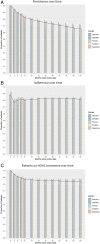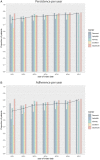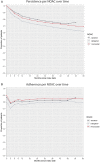Persistence and adherence to non-vitamin K antagonist oral anticoagulant treatment in patients with atrial fibrillation across five Western European countries
- PMID: 34096584
- PMCID: PMC8576279
- DOI: 10.1093/europace/euab091
Persistence and adherence to non-vitamin K antagonist oral anticoagulant treatment in patients with atrial fibrillation across five Western European countries
Abstract
Aims: To assess persistence and adherence to non-vitamin K antagonist oral anticoagulant (NOAC) treatment in patients with atrial fibrillation (AF) in five Western European healthcare settings.
Methods and results: We conducted a multi-country observational cohort study, including 559 445 AF patients initiating NOAC therapy from Stockholm (Sweden), Denmark, Scotland, Norway, and Germany between 2011 and 2018. Patients were followed from their first prescription until they switched to a vitamin K antagonist, emigrated, died, or the end of follow-up. We measured persistence and adherence over time and defined adequate adherence as medication possession rate ≥90% among persistent patients only.
Results: Overall, persistence declined to 82% after 1 year and to 63% after 5 years. When including restarters of NOAC treatment, 85% of the patients were treated with NOACs after 5 years. The proportion of patients with adequate adherence remained above 80% throughout follow-up. Persistence and adherence were similar between countries and was higher in patients starting treatment in later years. Both first year persistence and adherence were lower with dabigatran (persistence: 77%, adherence: 65%) compared with apixaban (86% and 75%) and rivaroxaban (83% and 75%) and were statistically lower after adjusting for patient characteristics. Adherence and persistence with dabigatran remained lower throughout follow-up.
Conclusion: Persistence and adherence were high among NOAC users in five Western European healthcare settings and increased in later years. Dabigatran use was associated with slightly lower persistence and adherence compared with apixaban and rivaroxaban.
Keywords: Adherence; Atrial fibrillation; Oral anticoagulants; Persistence; Stroke.
© The Author(s) 2021. Published by Oxford University Press on behalf of the European Society of Cardiology.
Figures



Similar articles
-
Drug Utilization Pattern of Oral Anticoagulants in Patients with Atrial Fibrillation: A Nationwide Population-Based Study in Korea.Adv Ther. 2022 Jul;39(7):3112-3130. doi: 10.1007/s12325-022-02151-z. Epub 2022 May 7. Adv Ther. 2022. PMID: 35524839 Clinical Trial.
-
Adherence to Rivaroxaban, Dabigatran, and Apixaban for Stroke Prevention in Incident, Treatment-Naïve Nonvalvular Atrial Fibrillation.J Manag Care Spec Pharm. 2016 Nov;22(11):1319-1329. doi: 10.18553/jmcp.2016.22.11.1319. J Manag Care Spec Pharm. 2016. PMID: 27783556 Free PMC article.
-
Medium- to long-term persistence with non-vitamin-K oral anticoagulants in patients with atrial fibrillation: Australian experience.Curr Med Res Opin. 2017 Jul;33(7):1337-1341. doi: 10.1080/03007995.2017.1321535. Epub 2017 May 10. Curr Med Res Opin. 2017. PMID: 28425296
-
Direct comparative effectiveness and safety between non-vitamin K antagonist oral anticoagulants for stroke prevention in nonvalvular atrial fibrillation: a systematic review and meta-analysis of observational studies.Eur J Epidemiol. 2019 Feb;34(2):173-190. doi: 10.1007/s10654-018-0415-7. Epub 2018 Jun 8. Eur J Epidemiol. 2019. PMID: 29948370
-
Real-World Adherence and Persistence to Direct Oral Anticoagulants in Patients With Atrial Fibrillation: A Systematic Review and Meta-Analysis.Circ Cardiovasc Qual Outcomes. 2020 Mar;13(3):e005969. doi: 10.1161/CIRCOUTCOMES.119.005969. Epub 2020 Mar 9. Circ Cardiovasc Qual Outcomes. 2020. PMID: 32148102
Cited by
-
Prevalence and Predictors of Nonadherence to Direct Oral Anticoagulant Treatment in Patients with Atrial Fibrillation.TH Open. 2023 Sep 27;7(3):e270-e279. doi: 10.1055/a-2161-0928. eCollection 2023 Jul. TH Open. 2023. PMID: 37772087 Free PMC article.
-
Edoxaban treatment in routine clinical practice is highly concordant with the 2020 European Society of Cardiology atrial fibrillation guidelines: results from the noninterventional Global ETNA-AF programme.Eur Heart J Open. 2025 Mar 28;5(2):oeaf004. doi: 10.1093/ehjopen/oeaf004. eCollection 2025 Mar. Eur Heart J Open. 2025. PMID: 40161305 Free PMC article.
-
Lifeday coverage of oral anticoagulants and one-year relative survival in patients with atrial fibrillation: a population-based study in Estonia.BMC Cardiovasc Disord. 2023 Aug 11;23(1):398. doi: 10.1186/s12872-023-03415-4. BMC Cardiovasc Disord. 2023. PMID: 37568101 Free PMC article.
-
Adherence and persistence with direct oral anticoagulants by dose regimen: A systematic review.Br J Clin Pharmacol. 2025 Apr;91(4):1096-1113. doi: 10.1002/bcp.70003. Epub 2025 Feb 16. Br J Clin Pharmacol. 2025. PMID: 39957057 Free PMC article.
-
Risk Profiles of New Users of Oral Anticoagulants Between 2011 and 2019 in Germany.Clin Epidemiol. 2023 Jul 18;15:827-837. doi: 10.2147/CLEP.S405585. eCollection 2023. Clin Epidemiol. 2023. PMID: 37483262 Free PMC article.
References
-
- Hindricks G, Potpara T, Dagres N, Arbelo E, Bax JJ, Blomström-Lundqvist C. et al. 2020 ESC Guidelines for the diagnosis and management of atrial fibrillation developed in collaboration with the European Association of Cardio-Thoracic Surgery (EACTS). Eur Heart J 2021;42:373–498. - PubMed
-
- Ruff CT, Giugliano RP, Braunwald E, Hoffman EB, Deenadayalu N, Ezekowitz MD. et al. Comparison of the efficacy and safety of new oral anticoagulants with warfarin in patients with atrial fibrillation: a meta-analysis of randomised trials. Lancet 2014;383:955–62. - PubMed
-
- Heidbuchel H, Vrijens B.. Non-vitamin K antagonist oral anticoagulants (NOAC): considerations on once- vs. twice-daily regimens and their potential impact on medication adherence. Europace 2015;17:1317–8. - PubMed
Publication types
MeSH terms
Substances
LinkOut - more resources
Full Text Sources
Medical

